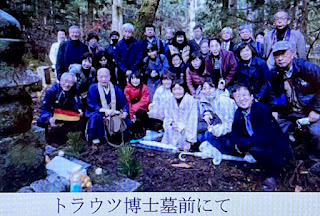 |
| 岩井武俊 to Dr. Trautz 都良宇津 |
Although the backside of this postcard appears to be handwritten, it is actually printed. The cardstock seems to be made from sturdy rice paper (hanshi). In it, Taketoshi Iwai addresses this New Year's card to F. M. Trautz, using an uncommon written form of his name in kanji, 都良宇津.
Taketoshi Iwai (1886-1965) was a historian, journalist, author, and a Kyoto bureau chief of the Osaka Mainichi Newspaper from about 1927-1942. He authored a number of works on historical houses, temples, shrines, and architecture around Kyoto. One of them is titled 京郊民家譜 (Kyōkō Minkafu), Traditional Folk Houses of Kyoto Suburbs.
 |
| Taketoshi Iwai (circled) image credit: https://discoverjapan-web.com/article/12413 |
This book provides valuable insights into the traditional folk houses and architecture found in the suburbs of Kyoto, Japan. While Taketoshi Iwai may not be a widely recognized figure, his contributions to documenting and preserving knowledge about the traditional architecture in the Kyoto region are noteworthy, especially for those interested in Japanese history and culture.
This book offers valuable insights into the architectural heritage of the Kyoto region, focusing on the lesser-known, everyday structures found in suburban areas. These houses often exemplify traditional Japanese architecture, showcasing elements such as tatami mat rooms, shoji screens, and wooden beams. Iwai's work goes beyond mere documentation; it aims to celebrate and preserve the architectural traditions that have played a vital role in shaping the unique cultural landscape of Kyoto.
京郊民家譜 photo credit: Yasuda Shoten
By cataloging these folk houses and providing detailed descriptions, "京郊民家譜" contributes to the broader understanding of how architectural styles evolved in Japan and reflects the cultural and historical significance of the Kyoto region. This book is not only a valuable resource for scholars and researchers but also for anyone interested in Japanese architecture, history, and culture.
Taketoshi Iwai's dedication to documenting and celebrating these suburban folk houses is a testament to the importance of preserving cultural heritage. "京郊民家譜" continues to be a valuable resource for those looking to explore the architectural and cultural traditions of Kyoto, and it serves as a reminder of the rich history and craftsmanship found in everyday structures that have often been overshadowed by more famous landmarks.









